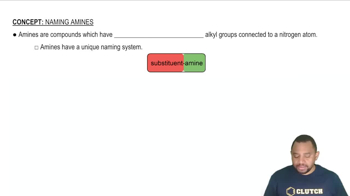Here are the essential concepts you must grasp in order to answer the question correctly.
Acid-Base Reactions
Acid-base reactions involve the transfer of protons (H+) between reactants. In this context, an amine, which acts as a base, accepts a proton from an acid, such as HCl. The result is the formation of an ammonium ion and a chloride ion, illustrating the fundamental principle of proton transfer in acid-base chemistry.
Recommended video:
Amine Structure and Properties
Amines are organic compounds derived from ammonia (NH3) by replacing one or more hydrogen atoms with alkyl or aryl groups. They can act as bases due to the presence of a lone pair of electrons on the nitrogen atom, which can accept protons. Understanding the structure of amines is crucial for predicting their reactivity in acid-base reactions.
Recommended video:
Condensation Reactions
Condensation reactions involve the combination of two molecules with the loss of a small molecule, often water. While the given reaction is primarily an acid-base reaction, recognizing condensation reactions is important in organic chemistry, as they often lead to the formation of larger, more complex molecules through the elimination of simpler ones.
Recommended video:
 Verified step by step guidance
Verified step by step guidance


